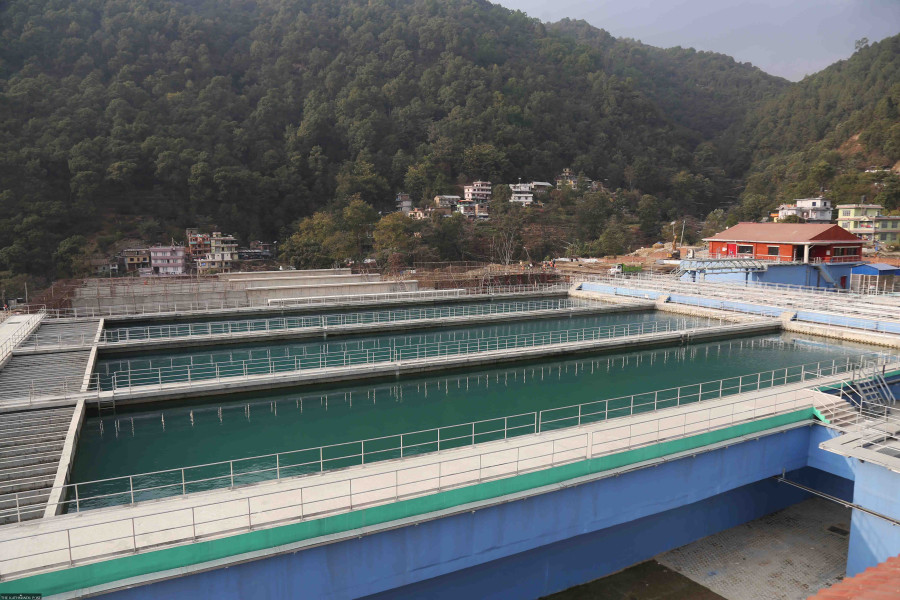Money
Kathmandu to get water from Bagmati during monsoon
KUKL will divert 100 million litres of water daily from the river to the Sundarijal water treatment plant, officials said.
Pawan Pandey
The government has planned to bring water from the Bagmati River at Sundarijal to Kathmandu for at least four months during the monsoon as supply from the Melamchi River will be disrupted.
Kathmandu Upatyaka Khanepani Limited (KUKL) will divert 100 million litres of water daily from the river to the Sundarijal water treatment plant, 15 km northeast of Kathmandu, said Prakash Rai, spokesperson for the state-owned water utility.
“We now have two 12-inch pipes to divert water from the Bagmati and send it to the treatment plant,” said Rai. “The procurement process to install another 20-inch pipe is underway.”
Kathmandu Valley's teeming population requires around 470 million litres of water daily, but KUKL is able to meet only about half of the requirement.
In March 2021, water from the Melamchi River in Sindhupalchok district finally made it to thirsty Kathmandu after a decades-long wait, countless deadline extensions and Rs60 billion in expenses.
But the long-expected torrent from the Melamchi Water Supply Project, that was to rescue the parched valley, was held up by another setback a few months later. In June 2021, a raging Melamchi River destroyed the headworks besides submerging much of Melamchi town.
“As the headworks of the Melamchi project is still covered by the debris brought by the massive flood in June 2021, the intake will remain closed during the four months of the monsoon,” said Rai.
The rainy season generally begins in mid-June and lasts till early October.
Water from Melamchi is currently being channelled to Kathmandu using a temporary arrangement. The water is treated at the Sundarijal plant before it is distributed to households.
KUKL receives 170 million litres from Melamchi and 120 million litres from other surface and groundwater sources daily, of which 260 million litres is piped into homes. “We use the remaining 30 million litres to test the new distribution network,” said Rai.
The Melamchi flood, which experts said was caused by the river bursting through a landslide dam following incessant rainfall, resulted in immense damage to the Melamchi Water Supply Project.
The headworks of the project was submerged under 20-24 metres of debris, but the tunnel was saved as it was closed when the disaster occurred, according to the Ministry of Water Supply.
Rajendra Prasad Pant, spokesperson for the Melamchi Water Supply Development Board, said a report of the damage assessment conducted by the Ministry of Water Supply and the Asian Development Bank was yet to come.
"The report will also recommend a permanent solution for the headworks," he said.
Water supply to the valley resumed in April last year when the shortage usually worsens.
Supply was again discontinued for six months after the start of the monsoon in June to protect the project in case there was another flood.
Melamchi water is currently being distributed to households inside the ring road and a few places in Bhaktapur and Kirtipur.
"The water distribution network has been damaged at places by construction and repair work conducted by other utilities," said Rajendra Sapkota, project director at the Project Implementation Directorate of KUKL.
“When testing the new distribution network, we found that it had been harmed by the construction and maintenance work on roads and sewers by third parties, and the project to put electricity and telephone cables underground,” he told the Post in a recent interview.
“This has caused leakages and increased the repair costs. Since most of the water collection ponds are outside the ring road, there is growing demand for Melamchi water from residents in such areas,” Sapkota said.
“There is an old distribution network in some places, but a new one is required to address demand. We estimate that it will cost around Rs24 billion to expand the network to a distance of 3-km from the ring road.”
According to Sapkota, the network will be around 1,700 km in length.
“While a detailed project report will be completed by the end of the current fiscal year, we have already informed the Finance Ministry for the financial arrangement,” Sapkota added.
The distribution network is being expanded outside the ring road at Mandikhatar and Kapan, and a 1,010 km-long network has been built inside the ring road.
“Testing work is being carried out on around 550 km,” Sapkota said. “Water is being regularly supplied to 300 km of the network.”
Pipe-laying work has been going on in Kalanki, Dhumbarahi, Maharajgunj and Balaju.
“The expansion of the distribution network inside the ring road will take six to eight months,” Sapkota said. “The network will be 1,600 km long after completion.”
The Melamchi Water Supply Development Board has created a plan to develop additional infrastructure to supply water throughout the year, according to spokesperson Pant.
“But the final budget estimate is yet to be made. We will finalise the estimate and send it to the Finance Ministry. If it is approved, the extra work will not take much time.”
Besides supplying 170 million litres of water in the first phase, the Melamchi project is estimated to obtain another 170 million litres of water each from the Yangri and Larke rivers, supplying 510 million litres of water daily to Kathmandu Valley in the second phase.
“Around Rs60 billion has already been spent on bringing water from Melamchi and distributing it to households in Kathmandu,” Pant said.
“Of the total cost, Rs31 billion has been spent on construction and other work on the Sindhupalchok-Sundarijal section.”
Senior watershed expert Madhukar Upadhya finds the efforts of the authorities concerned to make the Melamchi project functional inefficient.
“The project is always going to be at risk of flooding,” said Upadhya. “An attempt is being made to keep the project functional as billions have been spent on it,” said Upadhya.
He says that demand for water in the valley has been fulfilled by local sources, groundwater extraction, nearby rivers and supply from tankers, but the poor management and monitoring of these sources has been an issue.
“While the revival of stone spouts seems nearly impossible, both groundwater storages–the deep, which is finite, as well as the rechargeable shallow one–in the valley are under stress,” Upadhya said. “We are unaware of the repercussions of the reduction in the level of groundwater.”
Rai said Kathmandu Valley Drinking Water Management Board was studying other sources to bring water into the valley such as the Mahadev River in Bhaktapur and the Sisneri River, among others.
But Upadhya says the development of alternatives has been limited to discussions. “They have been overshadowed by the Melamchi project,” he added.




 14.12°C Kathmandu
14.12°C Kathmandu














